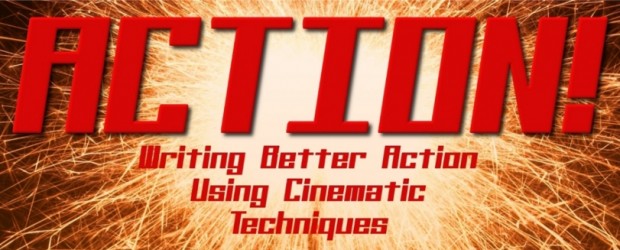To effectively create an action scene that meets both the needs of the story and the needs of the reader, you must think more like a movie director. This means that you must consider not only the characters and their goals, but their motion through a given scene. Action scenes require characters to be in motion, and the effective description of that motion is what makes the difference between a good, cinematic-quality action scene and a merely adequate one. By making this transition from good to great, your action scenes will be exciting to read, memorable, and have a visceral quality that will have your readers turning the pages, desperate to keep up.
Blocking and staging are terms for the motions a character performs during the course of the scene and in what order. Example: Joe enters the room, spots his opponent, Bob, and charges to attack him at the room’s center. Those are three simple stage directions one might find in a script, but they’re just as effective to use when planning out an action scene in a novel.
Scripting is the dialogue of the characters uttered during an action scene. It’s neither necessary nor welcome to place every single shout, grunt, or groan inside quotation marks. This is, after all, an action scene. But in movies, characters always seem to find enough time to carry on some kind of conversation during action scenes, whether taunting their opponents, arguing with them, calling for help, or uttering pithy zingers. Depending upon the tone you’re trying to create, dialogue can be a good addition to any action scene that demands cinematic quality.
Choreographing is the planning of specific stunts performed by the characters in your scene. Choreographing is not the same thing as blocking. In the above example, the blocking of Joe is to enter the room and move to meet Bob. Once they’re engaged in actual combat, choreographing takes the place of blocking. If Joe swings with a heavy left hook and follows it up with a knee to the nuts, that’s choreographing. In other words, choreographing is the blow-by-blow breakdown of any given action scene, the interaction of characters.
Taking the example of Joe vs. Bob a little further, we can identify the characteristics of each part of the scene:
Joe flung open the door [Blocking]. Bob smirked at him from across the room, raised his hand, and beckoned to Joe [Blocking]. “Come get some,” he said [Scripting].
With an inarticulate yell of rage, Joe charged across the floor as Bob dropped into a fighting stance [Blocking]. Joe launched a heavy left hook at Bob, but the man ducked underneath the blow [Choreographing]. Before Bob could respond, Joe drove his knee hard in between Bob’s legs [Choreographing].
Bob turned the same color as the floor, grabbed himself, and collapsed [Blocking].
Poor Bob. If only he knew the fundamentals of action scenes, he might have given a better accounting of himself. Let’s see if we can teach him.
More to come!
